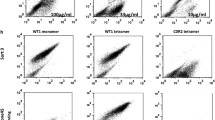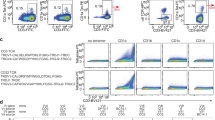Abstract
Human γδ T-lymphocytes expressing Vγ2Vδ2 T-cell receptors (TCRs) can be stimulated by aminobisphosphonates and can kill certain tumor cells. Although germline-encoded lysine residues on the Jγ1.2 segment have been demonstrated to be essential for the recognition of nonpeptide antigens by human γδ T-cells, the role of the junctional sequences of the TCR δ chain in the recognition of aminobisphosphonates by Vγ2Vδ2+T-cells remains unknown. We examined the structure of complementarity-determining region 3 (CDR3) of Vδ2 chains expressed by aminobisphosphonate-stimulated human γδ T-cells. CDR3 size-spectratyping analysis of Vδ2 chains revealed that risedronate did not induce a CDR3 size distribution pattern of Vδ2 cells that was distinct from that of Vδ2 cells cultured without risedronate. The clonality of risedronate-expanded Vδ2 T-cells was also determined by sequencing analysis, with the result that no particular consensus sequences were observed. However, most Vδ2 T-cells freshly isolated from peripheral blood carried a distinctive junctional motif consisting of a hydrophobic amino acid residue (valine, leucine, or isoleucine [Val/Leu/Ile]) at conserved position 97, and this feature was not altered by risedronate stimulation. A significant proportion of Vδ1 T-cells from the same individual had Leu at position 97, but Vδ1 T-cells did not expand in response to risedronate. Moreover, Vδ2 T-cells from the nonresponder against risedronate also carried a Val/Leu/Ile amino acid residue at position 97. These results suggest that the presence of a hydrophobic amino acid residue at position 97 in CDR3 of the TCR δ chain is not sufficient to account for the recognition of aminobisphosphonate by human γδ T-cells.
Similar content being viewed by others
References
Watts NB, Harris ST, Genant HK, et al. Intermittent cyclical etidronate treatment of postmenopausal osteoporosis.N Engl J Med. 1990;323:73–79.
Berenson JR, Hillner BE, Kyle RA, et al, and the American Society of Clinical Oncology Bisphosphonates Expert Panel. American Society of Clinical Oncology clinical practice guidelines: the role of bisphosphonates in multiple myeloma.J Clin Oncol. 2002;20:3719–3736.
Hortobagyi GN, Theriault RL, Porter L, et al. Efficacy of pamidronate in reducing skeletal complications in patients with breast cancer and lytic bone metastases: Protocol 19 Aredia Breast Cancer Study Group.N Engl J Med. 1996;335:1785–1791.
Kunzmann V, Bauer E, Wilhelm M. γδ T-cell stimulation by pamidronate.N EnglJ Med. 1999;340:737–738.
Kunzmann V, Bauer E, Feurle J, Weissinger F, Tony HP, Wilhelm M. Stimulation of γδ T cells by aminobisphosphonates and induction of antiplasma cell activity in multiple myeloma.Blood. 2000;96:384–392.
Miyagawa F, Tanaka Y, Yamashita S, Minato N. Essential requirement of antigen presentation by monocyte lineage cells for the activation of primary human γδ T cells by aminobisphosphonate antigen.J Immunol. 2001;166:5508–5514.
Das H, Wang L, Kamath A, Bukowski JF. Vγ2Vδ2 T-cell receptor-mediated recognition of aminobisphosphonates.Blood. 2001;98:1616–1618.
Kato Y, Tanaka Y, Miyagawa F, Yamashita S, Minato N. Targeting of tumor cells for human γδ T cells by nonpeptide antigens.J Immunol. 2001;167:5092–5098.
Wilhelm M, Kunzmann V, Eckstein S, et al. γδ T cells for immune therapy of patients with lymphoid malignancies.Blood. 2003;102:200–206.
Dieli F, Gebbia N, Poccia F, et al. Induction of γδ T-lymphocyte effector functions by bisphosphonate zoledronic acid in cancer patients in vivo.Blood. 2003;102:2310–2311.
Miyagawa F, Tanaka Y, Yamashita S, et al. Essential contribution of germline-encoded lysine residues in Jγ1.2 segment to the recognition of nonpeptide antigens by human γδ T cells.J Immunol. 2001; 167:6773–6779.
Hirokawa M, Horiuchi T, Kawabata Y, Kitabayashi A, Miura AB. Reconstitution of γδ T cell repertoire diversity after human allogeneic hematopoietic cell transplantation and the role for peripheral expansion of mature T cell population in the graft.Bone Marrow Transplant. 2000;26:177–185.
Bukowski JF, Morita CT, Band H, Brenner MB. Crucial role of TCRγ chain junctional region in prenyl pyrophosphate antigen recognition by γδ T cells.J Immunol. 1998;161:286–293.
Davodeau F, Peyrat MA, Hallet MM, Houde I, Vie H, Bonneville M. Peripheral selection of antigen receptor junctional features in a major human γδ subset.Eur J Immunol. 1993;23:804–808.
Tanaka Y, Sano S, Nieves E, et al. Nonpeptide ligands for human γδ T cells.Proc Natl Acad Sci U S A. 1994;91:8175–8179.
Tanaka Y, Morita CT, TanakaY, Nieves E, Brenner MB, Bloom BR. Natural and synthetic non-peptide antigens recognized by human γδ T cells.Nature. 1995;375:155–158.
Allison TJ, Winter CC, Fournie JJ, Bonneville M, Garboczi DN. Structure of a human γδ T-cell antigen receptor.Nature. 2001;411:820–824.
IMGT Repertoire: global ImMunoGeneTics Web resource for immunoglobulins (IG), T cell receptors (TR) and major histo-compatibility complex (MHC) and related proteins of the immune system (RPI). IMGT Marie-Paule Web site. Available at: http://imgt.cines.fr/textes/IMGTrepertoire. Accessed March 11, 2004.
Gober HJ, Kistowska M, Angman L, Jeno P, Mori L, De Libero G. Human T cell receptor γδ cells recognize endogenous mevalonate metabolites in tumor cells.J Exp Med. 2003;197:163–168.
Bukowski JF, Morita CT, Brenner MB. Human γδ T cells recognize alkylamines derived from microbes, edible plants, and tea: implications for innate immunity.Immunity. 1999;11:57–65.
Author information
Authors and Affiliations
Corresponding author
About this article
Cite this article
Nishimura, H., Hirokawa, M., Fujishima, N. et al. Contribution of Complementarity-Determining Region 3 of the T-Cell Receptor Vδ2 Chain to the Recognition of Aminobisphosphonates by Human γδ T-Cells. Int J Hematol 79, 369–376 (2004). https://doi.org/10.1532/IJH97.03157
Received:
Revised:
Accepted:
Published:
Issue Date:
DOI: https://doi.org/10.1532/IJH97.03157




